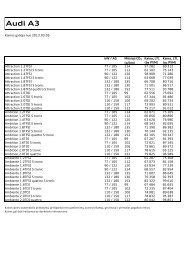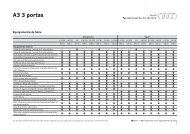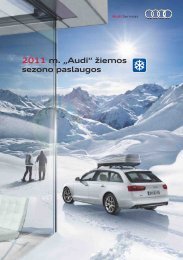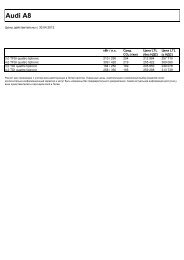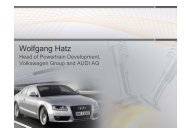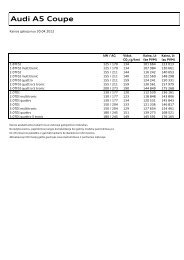Environmental Declaration 2010 for the Audi Plant in Ingolstadt
Environmental Declaration 2010 for the Audi Plant in Ingolstadt
Environmental Declaration 2010 for the Audi Plant in Ingolstadt
You also want an ePaper? Increase the reach of your titles
YUMPU automatically turns print PDFs into web optimized ePapers that Google loves.
Significant changes compared to 2008 –<br />
Data and facts about environmental protection<br />
The <strong>in</strong>put-output balance sheet provides <strong>in</strong><strong>for</strong>mation<br />
about <strong>the</strong> <strong>in</strong>com<strong>in</strong>g and outgo<strong>in</strong>g material and energy<br />
flows at <strong>the</strong> <strong>Ingolstadt</strong> plant <strong>in</strong> 2009, as well as<br />
about <strong>the</strong> changes <strong>in</strong> <strong>the</strong>m compared to previous<br />
years. For example, alum<strong>in</strong>ium consumption <strong>in</strong>creased<br />
as a result of <strong>the</strong> <strong>in</strong>creased use of alum<strong>in</strong>ium<br />
components <strong>in</strong> new model, among o<strong>the</strong>r th<strong>in</strong>gs.<br />
Steel consumption has decl<strong>in</strong>ed due to <strong>the</strong> vehicle<br />
programme and <strong>in</strong>crease <strong>in</strong> <strong>the</strong> degree of material use.<br />
Accord<strong>in</strong>gly, <strong>the</strong> steel scrap percentage fell compared<br />
to <strong>the</strong> previous year. Products that have been delivered<br />
from <strong>the</strong> <strong>Ingolstadt</strong> plant to o<strong>the</strong>r <strong>Audi</strong> plants are also<br />
<strong>in</strong>cluded. Fur<strong>the</strong>rmore, products and manufactur<strong>in</strong>g<br />
depth cont<strong>in</strong>ued to differ between <strong>the</strong> <strong>in</strong>dividual<br />
plants and also with<strong>in</strong> <strong>the</strong> <strong>in</strong>dustry. So it is only<br />
possible to make a qualified direct comparison of<br />
<strong>in</strong>put/output data. For this reason, <strong>Audi</strong> <strong>Ingolstadt</strong><br />
usually presents its environmentally relevant material<br />
and energy flows <strong>in</strong> absolute quantities.<br />
Changes accord<strong>in</strong>g to EMAS III<br />
The <strong>in</strong>put-output balance was supplemented beyond<br />
this with <strong>the</strong> <strong>in</strong>dicators called <strong>for</strong> <strong>in</strong> EMAS III Annex IV.<br />
These were identified.<br />
The new key per<strong>for</strong>mance <strong>in</strong>dicator <strong>for</strong> <strong>the</strong> total<br />
consumption of renewable energy consists of <strong>the</strong><br />
quantity of electricity from regenerative energy and<br />
<strong>the</strong> district heat<strong>in</strong>g supplied to <strong>Audi</strong> (waste heat of<br />
<strong>the</strong> <strong>Ingolstadt</strong> waste recycl<strong>in</strong>g plant). The product<br />
output corresponds to <strong>the</strong> total output quantity of all<br />
vehicles produced and parts delivered to o<strong>the</strong>r sites<br />
(spare parts, CKD volumes, pa<strong>in</strong>ted bodies and parts of<br />
<strong>the</strong> press<strong>in</strong>g shop). The total emissions of greenhouse<br />
gases <strong>in</strong> t CO2 equivalent consist of <strong>the</strong> greenhouse<br />
gases SF6, CO2 and refrigerant from stationary plants<br />
that emit at <strong>the</strong> <strong>Ingolstadt</strong> plant.<br />
To determ<strong>in</strong>e <strong>the</strong> SO2-, NOX-, and PM- emissions, <strong>the</strong><br />
major emission sources at <strong>the</strong> plant were considered.<br />
The area consumption refers to <strong>the</strong> sealed area of <strong>the</strong><br />
plant grounds.<br />
In addition, EMAS III demands publication of <strong>the</strong> core<br />
<strong>in</strong>dicators, which refer to <strong>the</strong> total output quantity.<br />
<strong>Audi</strong> meets this requirement with <strong>the</strong> tables listed on<br />
28<br />
<strong>the</strong> right, however, <strong>for</strong> <strong>the</strong> sake of greater clarity <strong>the</strong><br />
core <strong>in</strong>dicators refer to <strong>the</strong> total output quantity<br />
<strong>in</strong> kilotonnes (= 1000 tonnes) (see Output table<br />
page 30). In <strong>the</strong> area of material efficiency at <strong>the</strong><br />
<strong>Ingolstadt</strong> plant <strong>Audi</strong> refers to <strong>the</strong> most important<br />
environmental impacts, which are directly related to<br />
<strong>the</strong> material use of steel and alum<strong>in</strong>ium and <strong>the</strong> use<br />
of pa<strong>in</strong>ts and fillers. Both <strong>in</strong>dicators are<br />
supplemented <strong>in</strong> each case by <strong>the</strong> standard <strong>in</strong>dustry<br />
<strong>in</strong>dicator <strong>for</strong> <strong>the</strong> press<strong>in</strong>g shop (material use degree<br />
<strong>in</strong> percent) and <strong>for</strong> <strong>the</strong> pa<strong>in</strong>t shop (specific solvent<br />
emissions <strong>in</strong> g/m2).<br />
For <strong>the</strong> key area of waste, <strong>in</strong>dicators are shown on <strong>the</strong><br />
major hazardous and o<strong>the</strong>r wastes respectively.<br />
A higher <strong>in</strong>dicator, referr<strong>in</strong>g to <strong>the</strong> total waste volume<br />
at <strong>the</strong> plant, rounds off <strong>the</strong> picture.<br />
By means of <strong>the</strong> new core <strong>in</strong>dicators, <strong>Audi</strong> ensures that<br />
<strong>the</strong> environmental per<strong>for</strong>mance of major environmentally<br />
relevant processes at <strong>the</strong> plant are presented <strong>in</strong><br />
an undistorted and comprehensible manner.<br />
However, a direct comparison of <strong>the</strong> core <strong>in</strong>dicators<br />
with o<strong>the</strong>r sites is not possible due to <strong>the</strong> different<br />
manufactur<strong>in</strong>g processes.<br />
Core <strong>in</strong>dicators 2009<br />
Material efficiency and general <strong>in</strong><strong>for</strong>mation<br />
Material efficiency<br />
Energy: Total direct energy consumption (MWh) / Total output (kt) 1.294,75<br />
Water: Water consumption (m3) / Total output (kt) 1.435,93<br />
Biological diversity: Area consumption (sealed area <strong>in</strong> m2) / Total output (kt) 1.966,18<br />
Emissions: Total emissions of greenhouse gases (t-CO2equivalent) / Total output (kt) 154,03<br />
General In<strong>for</strong>mation<br />
Material use (steel and alum<strong>in</strong>ium) / Total output (t/kt) 364,13<br />
Degree of material utilisation <strong>in</strong> % 1) 54,90<br />
Pa<strong>in</strong>t and fillers / Total output (t/kt) 6,48<br />
1) In relation to all processes <strong>in</strong> press<strong>in</strong>g shop<br />
Waste<br />
Total waste / Total output 26,11<br />
Major hazardous waste types<br />
Emulsions / Total output (t/kt) 4,82<br />
Butyl-glycol water mixture / Total output (t/kt) 3,22<br />
Pa<strong>in</strong>t sludge/ Total output (t/kt) 1,76<br />
Mould<strong>in</strong>g sand / Total output (t/kt) 1,37<br />
Neutralisation sludge / Total output (t/kt) 1,25<br />
O<strong>the</strong>r important waste<br />
Metal waste / Total output (t/kt) 195,41<br />
Paper, cardboard, cardboard packag<strong>in</strong>g / Total output (t/kt) 4,43<br />
AEV* with sort<strong>in</strong>g / Total output (t/kt) 2,46<br />
AEV* without sort<strong>in</strong>g / Total output (t/kt) 1,30<br />
*AEV: Waste <strong>for</strong> use as energy<br />
29






